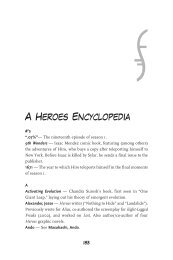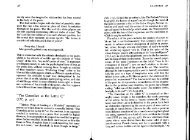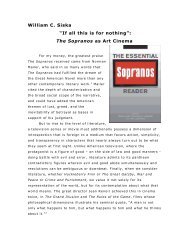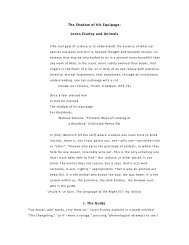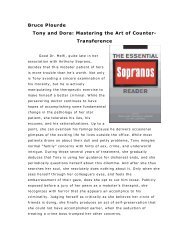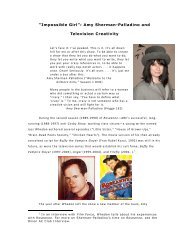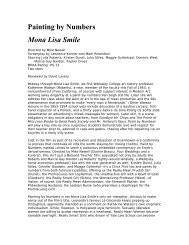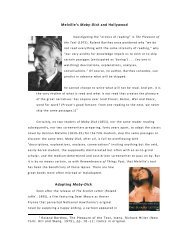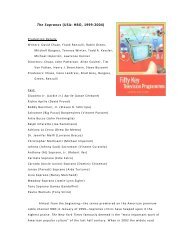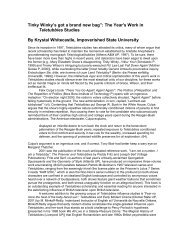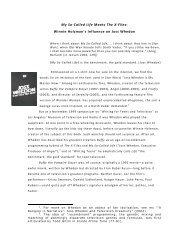It's Not Television, It's Magic Realism: The Mundane ... - David Lavery
It's Not Television, It's Magic Realism: The Mundane ... - David Lavery
It's Not Television, It's Magic Realism: The Mundane ... - David Lavery
You also want an ePaper? Increase the reach of your titles
YUMPU automatically turns print PDFs into web optimized ePapers that Google loves.
<br />
<br />
<br />
<strong>It's</strong> <strong>Not</strong> <strong>Television</strong>, <strong>It's</strong> <strong>Magic</strong> <strong>Realism</strong>: <strong>The</strong> <strong>Mundane</strong>,<br />
the Grotesque, and the Fantastic in Six Feet Under<br />
It was one of those days when it’s a minute away from snowing. And <br />
there’s this electricity in the air, you can almost hear it, right? And <br />
this bag was just . . . dancing with me. Like a little kid begging me to <br />
play with it. For fifteen minutes. That’s the day I realized that there <br />
was this entire life behind things, and this incredibly benevolent force <br />
that wanted me to know there was no reason to be afraid. Ever. <br />
Ricky Fitts in American Beauty <br />
Watching this show with the simplistic mind‐set of a fan tuning in to <br />
‘All My Children’—Will Lisa show up alive? Will Nate and Brenda ever <br />
get back together?—does its creators a grave disservice. <strong>The</strong>re's a <br />
wisdom guiding this show that we may have never encountered on <br />
television before—and might not encounter again—paired with an <br />
intensity and an evanescent melancholy that can render even the <br />
simplest scenes heartbreakingly real. <br />
Heather Havrilesky, ‘One Wedding and Two Funerals’ <br />
Prologue: Getting Six Feet Under <br />
Because I am an American with HBO and thanks to the special benefits of <br />
procrastination, I was able to write the following pages after seeing the first three <br />
episodes of Season Four of Six Feet Under (6FU). Because of the subject I had <br />
proposed for this collection, two scenes especially captured my attention. <br />
<strong>The</strong> first is the opening sequence of the second episode, ‘In Case of Rapture’ <br />
(4.2). After 6FU’s much admired credit sequence (on which much more presently), <br />
‘Rapture’ opens on a close‐up of an inflatable, life‐size, rubber sex doll. As the <br />
camera pulls back, we find ourselves in a warehouse where two male employees are <br />
preparing the dolls for shipment to the AVN Awards, ‘the fuckin’ Oscars of porn.’ This <br />
is not the first time 6FU has acknowledged porn: in Season One’s ‘An Open Book’ <br />
(1.5), after all, the Fisher brothers bury, in an hilariously grotesque funeral, porn <br />
star Vivica St. John, electrocuted when her cat knocks her hair curlers into her <br />
bathtub, but experienced 6FU viewers, well aware that the first sequence of each <br />
episode always ends in a death (a demise that will bring new business to the Fishers), <br />
begin to wonder, as the hydrogen‐sampling sex toy employees act goofy and play <br />
with their dolls, exactly who will die. <br />
<strong>The</strong> camera tracks the two men out into the streets of Los Angeles, ‘the world <br />
capital of the denial of death’ (series creator Alan Ball on the Season One DVD),
<strong>The</strong> Collected Works of <strong>David</strong> <strong>Lavery</strong> 2<br />
following their truck, its open bed full of loosely tied‐ down inflated dolls, as the <br />
vehicle moves down a busy boulevard. Expecting the sort of fatal collision that killed <br />
the Fisher patriarch (Richard Jenkins) in the first five minutes of the series forty <br />
episodes ago, we immediately look for a bus, but none arrives. Instead, the dolls <br />
come loose from their moorings and begin to float away, filling the sky overhead in a <br />
surreal shot. After a quick cut, we find ourselves in the car of Dorothy Sheedy, a <br />
devout Christian woman—we know she is Christian because a bumper sticker on her <br />
Ford Taurus joyously proclaims ‘I brake for the rapture!’ (she is also listening to a <br />
Christian talk show on the car radio). <strong>The</strong> sophisticated 6FUer now begins to realize <br />
that this woman will be victim‐of‐the‐week and makes mental preparation for the <br />
fatal crash that will result when she is distracted by porn‐in‐the‐sky. <br />
But writer Rick Cleveland and director Daniel Attias have misdirected us <br />
masterfully; Sheedy does spy the dolls, of course, and, anxious not to be ‘left <br />
behind,’ leaves her car unmanned to run, fatally, into oncoming traffic, but not in <br />
pursuit of garish lips and prominent rubber breasts. In her eyes the grotesque dolls <br />
(shown in subjective camera) are anything but grotesque; indeed, they appear as <br />
angelic, fantastic, ascending beings, magically answering the call of the rapture. Only <br />
the audience—not the Fishers, not Dorothy’s blissfully naïve husband, not a funeral <br />
home full of mourners—grasps the dramatic irony of her perverse death. Later, Nate <br />
(Peter Krause) is angry with the deceased’s spouse because his faith makes him <br />
incapable of anger at his loss. <strong>The</strong> sequence reminds us, if somehow we had <br />
forgotten, that 6FU is a tremendous challenge to read, almost never telling the <br />
viewer how to take it, how to understand it, how to interpret it, how to judge its <br />
characters. <br />
<strong>The</strong> second Season Four sequence to which I want to call attention at the <br />
outset of this examination of 6FU’s generic allegiances is equally baffling, equally <br />
unclassifiable. In ‘Parallel Play’ (4.4), Federico Diaz (Freddy Rodriguez), the Fisher <br />
family’s Puerto Rican restorative artist, has a strange dream (at least we assume it is <br />
a dream, as is confirmed at the end of the sequence), clearly the product of his <br />
dalliance with the stripper Sophia, who has just manipulated him into agreeing to <br />
pay for new breast implants. Working, as usual, in the basement of the Fisher & Diaz <br />
Funeral Home (at dream’s end he will wake up at his desk there), he is distracted by <br />
music and light, by a strange unfolding scene in which he sees himself sitting on a <br />
sofa in a forest tableau, a Christ‐like Sophia crucified behind him, wrapped in a loin
<strong>The</strong> Collected Works of <strong>David</strong> <strong>Lavery</strong> 3<br />
cloth but naked from the waist up, blood streaming from below her soon‐to‐be‐<br />
surgically‐enhanced breasts. <br />
<strong>The</strong> dream cuts to a sequence of shots of Sophia stripping; her bleeding <br />
breasts (again); a priest to whom Federico has confessed his sins; Federico’s wife <br />
Vanessa, dressed like the Virgin Mary; Sophia’s young daughter; the birth of Federico <br />
and Vanessa’s daughter (at the end of Season One); Vanessa mopping Sophia’s <br />
brow—an ever‐present bottle of Tylenol (Sophia’s daughter’s only toy, a makeshift <br />
castanet, in an earlier scene) passing back and forth between the various dream <br />
personae. Together, Vanessa and Sophia (come down from on high) join to service <br />
Federico’s needs: the Tylenol bottle now contains oil, poured onto his feet, which <br />
Sophia begins to wash, but the act of cleansing turns into oral sex, and he awakens. <br />
One of the great dream sequences in a series known for its reveries (its only oneiric <br />
TV rivals are Twin Peaks, <strong>The</strong> Sopranos, and Buffy the Vampire Slayer), Federico’s <br />
vision draws on the Hispanic imagination, tapping the tradition of magical realist art <br />
exemplified in the work of the great Mexican painter Frida Kahlo (1907‐54): imagery <br />
from paintings like A Few Small Nips (1935), <strong>The</strong> Two Fridas (1939), and Tree of Hope <br />
(1948), all dealing with surgery and hospitalization, informs the dream. <br />
A Few Small Nips <br />
<strong>The</strong> Collected Works of <strong>David</strong> <strong>Lavery</strong> 4<br />
<strong>The</strong> Two Fridas <br />
<strong>The</strong> Tree of Hope <br />
<br />
<strong>The</strong> Collected Works of <strong>David</strong> <strong>Lavery</strong> 5<br />
Take note that in order to describe what amounts to less than five minutes of <br />
TV I needed to resort to a vocabulary not all that common in televisual parlance: ‘the <br />
grotesque,’ ‘fantastic,’ ‘magical realist.’ Discourse about 6FU does not, to be sure, <br />
always require such exotic vocabulary; these are not the only registers/modes in <br />
which the series functions. Its detractors, after all, find it anything but generically <br />
extraordinary, calling it ‘a sitcom with elephantiasis’ (Carson 2002), or writing it off <br />
as a soap opera (Nussbaum 2002; Buckman 2004), and even its staunchest defenders <br />
single out as its greatest virtue its rendering of not the bizarre but ‘the mundane <br />
catastrophes of day‐to‐day life’ (Havrilesky 2002). Beginning with its opening credits, <br />
however, 6FU invites, indeed insists, that we see it/read it as something quite <br />
different. <br />
<br />
<strong>The</strong> Opening Credits <br />
A bird crosses blue sky. <strong>The</strong> camera tilts down to reveal a single tree at the <br />
horizon line where a hill of grass meets the sky. Two hands break apart in slow <br />
motion. A man’s hands are washed. <strong>The</strong> camera tilts to reveal two feet on a gurney—<br />
the big toe of the left foot bears an ID tag. Open sky again. A gurney moves down an <br />
institutional hallway—light at the end of the tunnel. From what might be the point‐<br />
of‐view of the body it bears, the gurney enters the light. Seen through a bottle of <br />
fluid, a man in a white coat moves about. A beaker of liquid (embalming fluid?) <br />
slowly empties. <strong>The</strong> head of a corpse turns away from the camera. In close‐up, a ball <br />
of cotton held in a pair of tweezers washes the corpse’s eye. A tilt moves up the <br />
corpse’s body from its feet, stopping before showing the head. A jump cut reveals a <br />
vase of flowers dying (wilting) in time‐lapse. A hearse door opens, a coffin within. In <br />
close‐ up the mortician’s hand grabs the coffin’s handle. (In earlier versions of the <br />
sequence, ‘Under the Main Titles: A Featurette on the Making of the Six Feet Under <br />
Main Titles’ reveals, a clearly visible skull ring can be seen on the mortician’s finger, <br />
but the memento mori was digitally removed in the final cut.) <strong>The</strong> hearse seen from <br />
behind, its load door wide open. A still life of two framed photos. In close‐up, a <br />
crow’s feet move slowly. A tombstone bears the words ‘Executive Producer Alan <br />
Ball.’ <strong>The</strong> crow stands on a tombstone. <strong>The</strong> sky again, crossed by a bird (the crow?). <br />
<strong>The</strong> hill and tree from earlier in the sequence. <strong>The</strong> tree puts down roots, forming a <br />
box in which the words ‘Six Feet Under’ appear. <br />
When 6FU creator and executive producer Ball first saw Digital Kitchen’s <br />
storyboard for this enigmatic, metaphysical opening credit sequence, he recalls
<strong>The</strong> Collected Works of <strong>David</strong> <strong>Lavery</strong> 6<br />
finding it ‘so elegant . . . so cinematic, . . . so unlike TV’ (my emphasis). Ball, of <br />
course, had become prime mover on 6FU largely on the strength of his Academy <br />
Award winning screenplay for the movie American Beauty (Sam Mendes 1999), and <br />
though he was not new to TV (he had written for Grace Under Fire [1993], Cybil <br />
[1995], and Oh Grow Up! [1999] prior to attaining auteur status with his first film <br />
script], it should surprise no one, least of all his bosses at HBO, that from the outset <br />
Ball would be anxious to distinguish, in the premium channel’s tradition, his series <br />
from ordinary television. Even the best makers of television—Buffy the Vampire <br />
Slayer’s Joss Whedon, for example, or <strong>The</strong> Sopranos’ <strong>David</strong> Chase— commonly insist <br />
upon their disdain for TV and dream of escaping to the greener grass of the movies <br />
(see <strong>Lavery</strong> 2002 and <strong>Lavery</strong> and Thompson 2002). <br />
And yet, as Ball readily acknowledges in ‘Under the Main Titles,’ the opening <br />
title sequence ‘transports you into the world of the show . . . ‘, which is, of course, <br />
precisely what the credit sequence of any quality television series, network or cable, <br />
is supposed to do. <strong>The</strong> ‘Welcome to Twin Peaks’ road sign, the falls, the lake beside <br />
which Laura Palmer’s body was found, ‘wrapped in plastic,’ transported us to the <br />
extraordinary diegesis of Twin Peaks. An eagle’s cry and an inquisitive moose <br />
prepared the viewer every week for a visit to Northern Exposure’s Cicely, Alaska. <br />
Tony Soprano’s cigar‐chomping drive from New York, past Satriale’s Pork Store, past <br />
urban New Jersey, to the front door of his palatial suburban home, ritualistically <br />
relocates us for a visit with <strong>The</strong> Family. <strong>The</strong>se and other memorable televisual <br />
opening credits, aided by signature music (by Thomas Newman [6FU], <strong>David</strong> Schwartz <br />
[Northern Exposure], Angelo Badalamenti [Twin Peaks], A3 [<strong>The</strong> Sopranos]), have long <br />
summoned viewers to step out of their household flow and into one‐of‐a‐kind <br />
television worlds (Altman 1986: 43‐44). 6FU’s opening credits may be superb, may be <br />
enthralling, may be cinematic, may be HBO, but they are still, at least functionally, <br />
TV. <br />
Executive producer Alan Poul’s understanding of the opening credits, <br />
however, takes the matter one step farther. ‘<strong>The</strong> theme music and title,’ Poul notes, <br />
thinking like a producer—like an employee of HBO and not just a creator—<br />
‘encapsulate the show so well in a kind of branding way that all you need is the <br />
opening chords or the image of the tree and it’s so evocative that people know what <br />
you are talking about’ (my emphasis). Poul’s choice of words is revealing. As Rogers, <br />
Epstein, and Reeves show in an essay on Six Feet Under’s big brother <strong>The</strong> Sopranos, <br />
HBO, a quintessential TV III show, is all about branding. (<strong>The</strong> eras can be
<strong>The</strong> Collected Works of <strong>David</strong> <strong>Lavery</strong> 7<br />
distinguished by their dominant forms of marketing: TV I—1948 to 1975—was ‘the <br />
age of mass marketing’; TV II—1975‐1995—was the age of niche marketing’; and TV <br />
III—1995 to the present—is the age of brand marketing [2002: 48].) <br />
<strong>The</strong> product of ‘a period when the digital revolution in distribution is again <br />
transforming what it means to watch television’ (Rogers, Epstein, and Reeves 2002: <br />
43), <br />
<br />
<br />
<strong>The</strong> Sopranos . . . is at the epicenter of a shift in the economic organization of <br />
the television industry. While premium cable has long operated according to a <br />
different revenue model than ad‐supported broadcast or basic cable services, <br />
HBO’s successful use of <strong>The</strong> Sopranos to build its brand and attract new <br />
subscribers represents a new level in the development of TV III. Because <br />
audiences pay directly for programming, either via a monthly subscription fee <br />
or on a pay‐ per‐view basis, content producers and packagers are shielded <br />
from the fear of offending nervous advertisers. As is evident to fans of <strong>The</strong> <br />
Sopranos, this commodity relation enables producers to exercise more <br />
creative freedom and opens the door to the exploration of more adult themes <br />
and the mining of more controversial content. <strong>The</strong> fee also helps to protect <br />
packagers from charges that viewers are inadvertently receiving offensive <br />
material. (2002: 47) <br />
Under CEO Jeffrey Bewkes HBO ‘produced programs that upped the ante on violence, <br />
sexuality, and the macabre’ (2002: 51). Six Feet Under, extremely edgy, very profane, <br />
highly sexual, very adult—very much the beneficiary of expanded creative freedom—<br />
was one of these programs. But if ‘<strong>The</strong> Sopranos is perfectly positioned to help HBO <br />
build its brand identity’ (2002 53), bringing imaginative life and economic power to <br />
its about‐to‐become‐a‐cliché branding slogan (‘It’s not TV. It’s HBO’), it does so as a <br />
representative of a readily identifiable genre: the gangster film. ‘[S]ystems of <br />
orientations, expectations, and conventions that circulate between industry, text, <br />
and subject’ (Neale 1980: 20), genre movies and series, <strong>The</strong> Sopranos included, lend <br />
themselves more easily to brand marketing than the difficult to classify Six Feet <br />
Under, a series which, like its opening credits, is a strange concoction: <br />
<br />
It’s very abstract, and there’s something kind of spooky about it but <br />
something kinda beautiful about it at the same time, and that sorta fits within
<br />
<strong>The</strong> Collected Works of <strong>David</strong> <strong>Lavery</strong> 8<br />
the tone of the show in which there are things that are sad and upsetting and <br />
ugly and depressing about life but there’s beauty in them as well. (Ball, <br />
director commentary for 6FU’s pilot) <br />
What on earth (or beneath it) is Six Feet Under? Are we certain Poul knows <br />
what he is talking about when he insists that 6FU viewers ‘know what you are talking <br />
about’ beginning with the opening credits? <strong>The</strong> sequence offer us the macabre (a <br />
corpse), the enigmatic (that crow might have flown right out of a poem by Wallace <br />
Stevens), the mystical (the white light into which the gurney and its passenger move <br />
is right out of the classic Near Death Experience), the self‐referential (Ball’s name on <br />
a tombstone carries on a cinematic tradition of auteur signature that includes <br />
Hitchcock’s cameos and the ultra‐violent Sam Peckinpah’s frequent visual association <br />
of his identity as director with instruments of violence), the naturally mysterious <br />
(that single tree, that verdant hillside). If HBO’s brand is ‘not TV,’ what is the <br />
trademark, the brand, ‘the mission statement,’ if you will, of this, its ‘not <strong>The</strong> <br />
Sopranos’ series? <br />
<br />
It’s <strong>Not</strong> TV, It’s the Grotesque . . . <br />
One ready‐to‐hand designation for Six Feet Under might be ‘grotesque.’ <br />
Needless to say, much of the often scatological, frequently‐immersed‐in‐ bodily‐<br />
fluids, always about bodies, both dead and alive, often ghoulish 6FU clearly invites <br />
such a seemingly non‐commercial branding. (HBO, after all, demonstrates a certain <br />
affinity for the grotesque, as Carnivale in its entirety and <strong>The</strong> Sopranos, Deadwood, <br />
Real Sex, Taxicab Confessions . . . upon occasion confirm.) <br />
<strong>David</strong> Fisher (in the 6FU pilot) rebukes his brother: ‘You want to get your <br />
hands dirty? You sanctimonious prick. Talk to me when you've had to stuff <br />
formaldehyde‐soaked cotton up your father's ass so he doesn't leak.’ A corpse <br />
displays an erection (a phenomenon, we learn, known as ‘angel lust’) and later <br />
defecates (‘<strong>The</strong> Will,’ 1.2). A man is accidentally sliced to pieces in a huge bread <br />
dough mixer (‘<strong>The</strong> Foot,’ 1.3). A lawyer dies from auto‐erotic asphyxiation while <br />
masturbating (‘Back to the Garden,’ 2.7). Blood erupts (twice) from the Fisher and <br />
Sons Funeral Home plumbing system—‘It’s like <strong>The</strong> Shining in here!’ Claire (Lauren <br />
Ambrose) proclaims (‘Parallel Play,’ 4.3). Claire steals a corpse’s foot in order to get <br />
back at her boyfriend for being labeled a ‘toe slut’ at school (‘<strong>The</strong> Foot,’ 1.3). A <br />
grossly fat corpse falls to the floor when the gurney collapses (‘Making Love Work,’
<strong>The</strong> Collected Works of <strong>David</strong> <strong>Lavery</strong> 9<br />
3.6). Rico restores the flattened face of a woman smashed in by a traffic light <br />
(‘Crossroads,’ 1.8). Funeral services for a porn star (‘An Open Book,’ 1.4) and a biker <br />
(‘It’s the Most Wonderful,’ 2008) turn into bizarre, over‐the‐top wakes. Claire does a <br />
portfolio of photographs of corpses (‘<strong>The</strong> Secret,’ 2.10). In ‘<strong>The</strong> Plan’ (2.3), Federico <br />
excitedly begins to describe to a widow the effects of cancer on her husband’s body <br />
until he is silenced by <strong>David</strong> (Michael C. Hall) (‘<strong>The</strong> Plan,’ 2.3). Claire’s art teacher <br />
Olivier (Peter Macdissi) praises her work with the strange compliment that it <br />
‘instantly makes me want to throw up’ (‘<strong>The</strong> Eye Inside,’ 3.3). A visiting artist at LAC <br />
Arts describes one of his favourite works: a Reagan‐era protest in which he ‘spent <br />
two nights roaming the streets of New York City in the dead of winter asking [the <br />
homeless mentally ill] to wipe their asses with [the American flag]’ (‘Nobody Sleeps,’ <br />
3.4). In Season Four mysterious boxes of shit (or ‘doo,’ as Arthur Martin [Rainn <br />
Wilson] refers to it) begin arriving at the Fisher house, addressed to Ruth’s (Frances <br />
Conroy) new husband George Sibley (James Cromwell). All these matters might be <br />
called grotesque. But is 6FU itself grotesque? <strong>The</strong> grotesque, as William J. Free has <br />
reminded us, is multi‐faceted. Its ‘fanciful and sinister’ nature is two‐faced, <br />
exemplified for Free in the paintings of Pieter Brueghel and Hieronymous Bosch. <br />
Brueghel's grotesque is an essentially comic ‘irreverent attitude toward his subject’ <br />
conveying ‘the artist's joy at contemplating the hurly‐burly confusion of life which <br />
swallows up any attempt of history to impose meaning on it.’ Bosch’s grotesque, on <br />
the other hand, is ‘terrifying,’ the manifestation of an ‘insanely demonic world <br />
peeping from beneath the order of life and threatening to destroy it in disgusting <br />
violence’ (Free 1978: 191). Philip Thomson agrees: ‘Writers on the grotesque have <br />
always tended to associate the grotesque with either the comic or the terrifying. <br />
Those who see it as a sub‐form of the comic class the grotesque, broadly, with the <br />
burlesque and the vulgarly funny. Those who emphasize the terrifying quality of the <br />
grotesque often shift it towards the realm of the uncanny, the mysterious, even the <br />
supernatural’ (Thomson 1972: 20). Our reaction to the grotesque is thus inherently <br />
complex, even contradictory. <strong>Not</strong> surprisingly, Thomson makes the grotesque’s <br />
‘unresolved clash of incompatibles in work and response’ part of its very definition <br />
and offers as a secondary, simplified definition: ‘the ambivalently abnormal’ (1972: <br />
27; emphasis in the original). Our cultural understanding of the grotesque has, <br />
however, been significantly altered by Mikhail Bakhtin’s Rabelais and His World <br />
(1968) and its championing of the carnivalesque grotesque he finds operative in <br />
Gargantua and Pantagruel, the ‘earthy,’ pre‐’bodily cannon’ celebration of the
<strong>The</strong> Collected Works of <strong>David</strong> <strong>Lavery</strong> 10<br />
‘grotesque’ body of pre‐Renaissance art in general and Rabelais in particular. <strong>The</strong> <br />
grotesque body, Bakhtin writes, unashamedly ‘fecundates and is fecundated, . . . <br />
gives birth and is born, devours and is devoured, drinks, defecates, is sick and dying’ <br />
(1968: 319). (<strong>The</strong> ‘bodily canon,’ as Bakhtin defines it [1968: 320‐21], censors the <br />
grotesque body, ‘assert[ing] instead that human beings exist outside the hierarchy of <br />
the cosmos. It stresses that we are finished products, defined characters, and in its <br />
reductionism attempts to seal off the bodily processes of organic life from any <br />
interchange with the external world.’) Thanks to Bakhtin, we can now see the artistic <br />
embrace of the grotesque not as a pack with the devil but an expression of ‘true . . . <br />
fearlessness’ (1968: 335) in the face of the human condition, an anti‐anal (in the <br />
Freudian sense) world view that accepts embodiment as ‘a point of transition in a <br />
life eternally renewed, the inexhaustible vessel of death and conception’ (1968: <br />
318). 6FU is hardly carnivalesque in Bakhtin’s sense (for that matter, neither is HBO’s <br />
Carnivale); its grotesqueness is too gross. But its infatuation with the grotesque is <br />
certainly shaded toward the comic pole of the axis. <strong>The</strong> grotesque body may not be <br />
exuberant or joyous in the series’ ongoing narrative, but it’s not exactly repressed <br />
either. Consider the following exchange between Nate and Rabbi Ari, to whom he has <br />
confessed his possibly fatal brain abnormality: <br />
<br />
<br />
Rabbi Ari: You must be really scared. <br />
Nate: Yeah. I’m going to die. <br />
Rabbi Ari: Yeah, me too. <br />
Nate: Really? What do you have? <br />
Rabbi Ari: A body. (‘Back to the Garden,’ Six Feet Under, 2.7) <br />
Coming from a woman who had earlier quoted in a funeral service the Talmudic <br />
proverbial wisdom ‘Better one day in this life than all eternity in the world to come,’ <br />
the Rabbi’s jest nevertheless blesses, on the behalf of the series itself, the return of <br />
the repressed and may well crystallize what Heather Havrilesky has intuited (but not <br />
identified) as the ‘wisdom guiding this show that we may have never encountered on <br />
television before—and might not encounter again’ (‘One Wedding and Two Funerals’; <br />
my emphasis). <br />
<strong>The</strong> Collected Works of <strong>David</strong> <strong>Lavery</strong> 11<br />
It’s <strong>Not</strong> TV, It’s the Fantastic . . . <br />
A series in which the dead are seldom really dead and routinely talk to the <br />
living, in which imagination and reality are difficult to distinguish, Six Feet Under is <br />
not only routinely grotesque but fantastic. ‘So long as we are uncertain whether we <br />
are witness to the natural or the supernatural,’ Diane Stevenson writes in an essay <br />
on the genre’s prominent role in Twin Peaks, ‘we are in the fantastic’ (Stevenson <br />
1970: 70). As the Russian writer Solovyev insists, the fantastic in its purest form as a <br />
genre ‘must never compel belief in a mystic interpretation of a vital event; it must <br />
rather point, or hint at it’ (quoted in Hawthorn 1998: 74). Drawing on Todorov’s <br />
thesis that historically the fantastic as a genre has functioned as a kind of pre‐<br />
scientific form of imagination—the heyday of the fantastic was the 19th century, he <br />
argues, because psychoanalysis had not yet appeared, and concomitantly, ‘<strong>The</strong> <br />
themes of fantastic literature have become, literally, the very themes of <br />
psychological investigations of the last fifty years’ (Todorov 1970: 160‐61)—<br />
Stevenson suggests that Twin Peaks’ disturbing representation of child sexual abuse <br />
resorted to the fantastic—making Laura Palmer’s molester and killer not really her <br />
father but a supremely evil, supernatural parasite named BOB!—because of the <br />
unthinkableness of the subject. If Twin Peaks resorted to the fantastic in order to <br />
come to grips with the incomprehensible, might it not be argued that 6FU’s use of <br />
the mode is inspired by a similar motive: in order to explore not the aberrant, <br />
unnatural inexplicableness of a father’s abuse and murder of a daughter but the <br />
ordinary, natural unfathomableness of death. If death, as someone once observed, is <br />
to us as sex was to the Victorians; if, as radical sociologist Ivan Illich once observed, <br />
we live in a time in which obituaries should properly be written in passive voice <br />
(‘<strong>David</strong> <strong>Lavery</strong> has been died today’)—death being now routinely thought of not as an <br />
existential given but as a failure of medicine; then how could a television series <br />
about a family of funeral directors not resort to the fantastic? In the 6FU pilot, at a <br />
dreary, subdued viewing of the body of their father, Nate tells Claire of a memory <br />
from a long‐ago back‐backing tour of Europe, and in his mindscreen we see the story <br />
unfold. He had been on a boat in the Mediterranean that delivered a coffin to a <br />
beach in Sicily: <br />
<br />
And there were all these old Sicilians, dressed up all in black, waiting, just <br />
lined up on the beach. And when they got that coffin to the beach, they just <br />
went ape‐shit, screaming, throwing themselves on it, beating their chests.
<br />
<strong>The</strong> Collected Works of <strong>David</strong> <strong>Lavery</strong> 12<br />
tearing at their hair, making animals noises. It was just so, so real. I mean, I <br />
had been around funerals all my life, but I had never seen such grief, and at <br />
the time it gave me the creeps, but now I think it’s probably so much <br />
healthier than this. <br />
Here, and on a weekly basis, 6FU, frequently going ape‐shit itself (narratively <br />
speaking), puts death in active voice, makes death real. ‘What's remarkable about, <br />
Six Feet Under,’ writes Carina Chocano, ‘is that it takes something everybody knows <br />
(we're all going to die) and calmly repeats it, with a surprising lack of morbidity and <br />
next to no moralizing, until everybody understands (we're all going to die!)’ <br />
(Chocano 2002). <strong>The</strong> fantastic and the grotesque are as essential to this transaction <br />
as they are to 6FU’s brand, but as genre identifications, they are simply not <br />
comprehensive enough to capture the series in all its complexity. <br />
<br />
It’s <strong>Not</strong> TV, It’s <strong>Magic</strong> <strong>Realism</strong> . . . <br />
A case could be made that 6FU’s dominant tendencies may be found, in germ, <br />
in a scene from Ball’s American Beauty. Mid‐film, the darkly morose but clearly <br />
brilliant Ricky Fitts (Wes Bentley) shows his new love Jane Burnham (Thora Birch) <br />
unusual film footage he captured with his always‐at‐ hand camcorder of a plastic bag <br />
and leaves blowing back and forth before a garage door. (We know from Ball’s <br />
‘Afterword’ to the film’s screenplay that ‘an encounter with a plastic bag outside the <br />
World Trade Center’ was one of American Beauty’s seed crystals [1999: 113], and on <br />
the DVD commentary, director Sam Mendes acknowledges that the plastic bag scene <br />
was the hook that convinced him to direct the film in the first place.) As a work of <br />
art Ricky’s film appears at first glance to be simple realism of the minimalist variety, <br />
but he sees in the image (and, thanks to Mendes, so do we) much, much more, as he <br />
explains to his audience of one in the words quoted as an epigraph to this essay. <br />
After a moment’s pause, during which Jane turns to watch him and not the screen, he <br />
confesses poignantly ‘Sometimes there’s so much beauty in the world I feel like I <br />
can’t take it . . . and my heart is going to cave in.’ When critics sometimes <br />
designated American Beauty as ‘magic realism,’ the plastic bag scene was central to <br />
their attention, and when Six Feet Under is similarly identified . . . is it not because <br />
of its comparable recognition, sometimes grotesque, sometimes fantastic, of ‘this <br />
entire life behind things’? <br />
<strong>The</strong> Collected Works of <strong>David</strong> <strong>Lavery</strong> 13<br />
<strong>The</strong> Latin American fiction of such writers as Marquez, Cortazar, Allende, and Borges <br />
made ‘magic realism’ a literary household word, but the term has not only created, <br />
in Borgesian fashion, ‘its own precursors’ (Borges 1999: 365) has become an <br />
international phenomenon, and has bled into other media as well. According to Leal, <br />
magic realism ‘can be expressed in popular or cultured forms, in elaborate or rustic <br />
styles in closed or open structures’ (Leal 1995: 119‐23); Menton and Weisgerber have <br />
already made strong cases for magic realist painting and cinema. Can television, ever <br />
infatuated with various notions of the ‘real,’ from You are <strong>The</strong>re to Survivor, be <br />
magically real? From its opening credit sequence, to those omnipresent ghosts, to its <br />
dream and NDE visions, to its first‐season‐only hyperreal mortuary ads, all co‐<br />
existing with life in the Fisher household, with school, with work (of morticians, <br />
florists, a Shiatsu masseuse, a policeman)—with, that is, the mundane—6FU <br />
encourages us to label its exploration of life and death ‘magic realism.’ <br />
<strong>The</strong> pursuit of the ‘marvelous’ in art, writes Alejo Carpenter, ’had, of course, <br />
been attempted before—by the fantastic, by surrealism . . .—but magical realism’s <br />
heuristic followed a different method, looked in a radically new direction: ‘if [earlier <br />
art forms] pursued the marvelous, one would have to say that [they] very rarely <br />
looked for it in reality’ (1995: 102‐104). <strong>Magic</strong> realism’s anything‐but‐sanguine‐world <br />
view is by no means all sweetness and light. As Danow is careful to note, it is, in fact, <br />
grounded in ‘a view of life that exudes a sense of energy and vitality in a world that <br />
promises not only joy, but a fair share of misery as well’ (Danow 1995: 65ff). In <br />
Robert Scholes’ terms a form of ‘metafiction,’ magic realist storytelling, according to <br />
Cuddon, is likely to recognize ‘the mingling and juxtaposition of the realistic and the <br />
fantastic, bizarre and skilful time shifts, convoluted and even labyrinthine narratives <br />
and plots, miscellaneous use of dreams, myths and fairy stories, expressionistic and <br />
even surrealistic description, arcane erudition, the elements of surprise or abrupt <br />
shock, the horrific and the inexplicable’ (1998: 488). In three plus seasons crowded <br />
with dreams, fantasies, time dislocations, esoteric knowledge (what the hell is <br />
fenugreek anyway?), mysteries and secrets, and a great deal of misery, 6FU lays <br />
claim to almost all these traits, keeping it simultaneously real, especially on the <br />
emotional level. When Alan Poul insisted that viewers of the series, prompted by the <br />
opening credits, would “know what you [presumably 6FU’s creators] are talking <br />
about,” the generic signature detailed here might well stand as what he was talking <br />
about.
<strong>The</strong> Collected Works of <strong>David</strong> <strong>Lavery</strong> 14<br />
In the worlds created by magical realists, “the supernatural is not a simple or <br />
obvious matter, but it is an ordinary matter, an everyday occurrence” (Zamora and <br />
Faris, Introduction: 3). In magic realism, Bruce Holland Rogers insists, “If there is a <br />
ghost . . . , the ghost is not a fantasy element but a manifestation of the reality of <br />
people who believe in and have ‘real’ experiences of ghosts. <strong>Magic</strong>al realist fiction <br />
depicts the real world of people whose reality is different from ours. <strong>It's</strong> not a <br />
thought experiment. <strong>It's</strong> not speculation. <strong>Magic</strong>al realism endeavors to show us the <br />
world through other eyes.” <strong>The</strong> fantastic offers us a world, as we have just seen, <br />
where “we are uncertain whether we are witness to the natural or the supernatural.” <br />
<strong>Magic</strong> realism is not agnostic. <strong>The</strong> supernatural exists; it is real, at least for a given <br />
subject. In a revealing scene in ‘<strong>The</strong> Plan’ (2.3) <strong>David</strong> and Nate talk of their father: <br />
<br />
<br />
Nate: Sometimes I kinda feel like Dad’s around. Do you ever? <br />
<strong>David</strong>: Nope. <br />
Moments later Nate asks psychic Marie Piper (Mare Winningham), whose husband <br />
the Fishers are burying and with whom she carries on a regular conversation even <br />
after his death, if she detects any presence of his father in the Fisher Funeral Home. <br />
She does not, though she admits she may be wrong since the house is full‐to‐<br />
overflowing with vestiges of the departed. As in the death‐by‐rapture of Dorothy <br />
Sheedy in Season Four, the scene is drenched with dramatic irony. For the viewer <br />
knows very well that neither Nate nor <strong>David</strong> is being quite honest: each of the Fisher <br />
boys communicates with their dead father. A plethora of ‘other eyes’ on 6FU see <br />
plenty of ghosts: Nathaniel Fisher, Sr., killed in the pilot, is a regular, appearing to <br />
all of the principal characters; many a loquacious corpse refuses to go gentle into <br />
that good night. With the exception of Sheedy’s delusional, fatal misreading of <br />
floating sex dolls, 6FU seldom debunks the alternate realities its characters are privy <br />
to. (“Six Feet Under," Laura Miller observes cogently, “is remarkable precisely <br />
because it refuses to instruct us on how to feel about its characters, something no <br />
other TV show does” [Miller 2002].) Drugs figure prominently in the series, giving <br />
people new eyes. Brenda smokes pot regularly, Claire does crystal meth and later <br />
mushrooms, inspiring the creation of a psychedelic pair of harem pants for her <br />
mother (‘<strong>The</strong> Liar and the Whore,’ 2.11). Three of the Fishers take ecstasy: <strong>David</strong> <br />
goes wild at a club (‘Life’s Too Short,’ 1.9); Nate finds himself blissfully high at a <br />
dysfunctional family dinner (‘In the Game,” 2.1); even Ruth, unwittingly does the
<strong>The</strong> Collected Works of <strong>David</strong> <strong>Lavery</strong> 15<br />
drug, resulting in her communing with nature on a camping trip with her lover Hiram <br />
(‘Life’s Too Short). 6FU does not judge these drug experience; it makes every effort <br />
instead to make their realities real to us. <br />
<br />
If 6FU’s narrative DNA, including the ‘chromosome’ bearing the tendency toward <br />
magic realism, is contained in its opening credits, its ‘genetics’ may be more than <br />
merely metaphorical. Can it be merely coincidental that the son of Gabriel Garcia <br />
Marquez (1928‐ ), Nobel Prize for Literature Laureate (1982) and magic realism’s <br />
patriarch, is one of 6FU’s important directors? Rodrigo Garcia (1959‐ ) has directed <br />
to date four episodes, including the second and third season premieres, and it will <br />
come as no surprise that some of the series’ most memorable, and most magical, <br />
moments are his work. <br />
Garcia directed, from a script by Christian Taylor, ‘<strong>The</strong> Room’ (1.6), in which <br />
investigation of a receipt he finds among his father’s records leads Nate Fisher to a <br />
mysterious back room at a restaurant the owner provided Nate, Sr. in payment for <br />
funeral services rendered. Sitting in his father’s sparsely‐furnished, tawdry <br />
hideaway, Nate discerns that it had evidently served as a refuge, a hang‐out, a place <br />
for his dad to get away from it all, and he imagines what he might have done there. <br />
In mindscreen we share his reverie: Nathaniel Fisher, Sr. smokes pot, dances and <br />
plays air guitar, hangs out with bikers, receives a blow job from a prostitute, fires <br />
repeatedly, Lee Harvey Oswald‐style, a high‐powered rifle with a sight out the room’s <br />
lone window. <strong>The</strong> unfolding montage is orchestrated to the words (sung by Ted <br />
Nugent) of the Amboy Dukes’ 1968 acid rock classic ‘Journey to the Center of the <br />
Mind’: “Leave your cares behind / Come with us and find / <strong>The</strong> pleasures of a journey <br />
to the center of the mind / Come along if you care / Come along if you dare / Take a <br />
ride to the land inside of your mind / Beyond the seas of thought / Beyond the realm <br />
of what / Across the streams of hopes and dreams where things are really not.” <br />
Garcia has succeeded in the difficult feat of taking us inside two minds, father and <br />
son, one imagining the other, each real in the eye of the beholder. <br />
Garcia directed, as well, from a script by Alan Ball, “In the Game” (2.1), in <br />
which, as I have already mentioned, Nate unwittingly takes Ecstasy before a dinner <br />
party at the Fisher house. Abandoned by Brenda (Rachel Griffiths) and his family, <br />
who find his drugged high spirits hard to take, he finds himself late at night alone <br />
with his father, who introduces him to two friends: the Grim Reaper, an urbane white <br />
man smoking a cigar, and Mama Life, a large, jovial African American woman. Clearly
<strong>The</strong> Collected Works of <strong>David</strong> <strong>Lavery</strong> 16<br />
old pals, the two play Chinese checkers, but Death cannot keep his hands off of Life, <br />
and as Nate looks on in amazement, he tries to mount her. Here, Garcia captures <br />
with gusto a scene simultaneously grotesque and comic.. <br />
And Garcia—again working with a Ball script—helmed “Perfect Circles” (3.1), <br />
the mind‐blowing opening sequence of which begins where Season Two left off—with <br />
Nate under the knife, brain surgeons operating on his arteriovenous malformation <br />
(AVM). Things are not going well (the surgeon asks for aneurysm clamps), and on the <br />
screen appears: <br />
<br />
<br />
NATHANIEL SAMUEL FISHER, JR. 1965 – 2002 <br />
In rapid succession, with seamless editing reminiscent of the final sequence in <br />
Kubrick’s 2001: A Space Odyssey, we see the following: a shot of Federico sitting at <br />
the foot of (Nate’s) corpse. Claire lying morosely on her bed. Ruth Fisher, dressed in <br />
a slip, ironing. <strong>David</strong> at his desk, weeping. Nate, worried he will be ‘late for his own <br />
funeral,’ impatiently watching his father eat—he is wolfing down ‘fenugreek’ (an <br />
ancient medicinal herb, used as an embalming agent [!], to enhances nursing <br />
mother’s milk supply, and as insect repellent), which he claims to be delicious with <br />
maple syrup (he counsels his son that he shouldn’t be in a hurry for he now has all <br />
the time in the world; ‘time doesn’t exist anyway,’ he adds); Nate stalks off and finds <br />
himself at his funeral, where he sees his family (including Lisa [Lili Taylor] and their <br />
baby Mia), stares at his own bald self on display (‘Damn it <strong>David</strong>, I said I wanted to <br />
be cremated!’). Moving into a nearby room he watches <strong>David</strong> trying to teach a near‐ <br />
catatonic Nate to pronounce words like ‘cat’ and ‘duck.’ <br />
Moving on, he watches himself with Lisa as they play with Mia on the floor. <br />
Hearing another baby crying, he discovers—smiling broadly—himself entering the <br />
Fisher home with Brenda and their baby. Following voices he looks on as the Fisher <br />
family eats dinner and engages in lively conversation about how George Bush stole <br />
the election and Nate voted for Nader. At another, smaller table, Nate, his father, his <br />
almost unrecognisable mother (blonde and completely bitchy), and his sister (this <br />
time not Claire) eat Christmas dinner until interrupted by a customer in need (a very <br />
competent, very involved Nate handles the phone call like an experienced funeral <br />
director). Again following voices in another room, he finds a redneck version of <br />
himself wearing a baseball cap and smoking a cigarette, who watches a strange <br />
television program: though it has the look and feel of a soap opera, we hear a laugh
<strong>The</strong> Collected Works of <strong>David</strong> <strong>Lavery</strong> 17<br />
track and find the characters talking about ‘Dr. Schrödinger’ and <br />
Copenhagen/Copenhagen (the Michael Frayn play about quantum physics? the Danish <br />
city?) and uttering lines like ‘We always end up in a universe in which we exist’ and <br />
‘Everything that can happen does.’ When this last line is uttered, Redneck Nate <br />
proclaims ‘I’ve seen this one before.’ Nate follows his clipboard‐carrying father <br />
(passing a man on the way who obliterates a wall clock with a sledge hammer) into a <br />
room with a coffin, full of mourners (all Nate‐on‐the‐operating‐table look‐a‐likes, all <br />
bald), where he begins to question his son (who wants desperately to know if he is <br />
alive or dead): <br />
<br />
<br />
1. Do you believe that your consciousness affects the behaviour of subatomic <br />
particles? <br />
2. Do you believe that particles move backward and forward in time and <br />
appear in all possible places at once. <br />
3. Do you believe that the universe is constantly splitting into billions of <br />
different parallel universes? <br />
Nate, Sr. again fails to give a straight answer to his son’s life or death <br />
question, explaining that he is both—and that in some universes he never existed in <br />
the first place. His insistence that Nate, Jr. ‘open the box’ (the coffin), causes the <br />
assembled audience of Nates to all don simultaneously identical sunglasses. (<strong>The</strong> <br />
coffin becomes, in effect, the famous box of Erwin Schrödinger’s reductio ad <br />
absurdum gedanken experiment, in which a cat, hidden in a box, may be either alive <br />
or dead, depending on whether or not light is a wave or a particle, but visually the <br />
‘box’ recalls the case (perhaps containing a nuclear weapon) opened at the end of <br />
the classic noir Kiss Me Deadly [Robert Aldrich 1955].) When Nate lifts the coffin lid, <br />
radiant light engulfs the room. Once again the NATHANIEL SAMUEL FISHER, JR. / 1965 <br />
– 2002 title appears, but the ‘2002’ fades away and we hear Nate’s voice at a <br />
barbeque talking about his surgery. If there has been a more extraordinary sequence <br />
in the history of television I have not seen it. Garcia and Ball’s collaboration here <br />
makes Cooper’s dream from Twin Peaks seem tame by comparison. <br />
Earlier, in my brief examination of the grotesque in 6FU, I catalogued Claire’s <br />
despicable/fascinating art professor Olivier’s insistence that good art makes him <br />
want to vomit. But there is more to his very postmodern aesthetic, as he goes on to <br />
explain in the same scene from “<strong>The</strong> Eye Inside”:
<br />
<br />
<strong>The</strong> Collected Works of <strong>David</strong> <strong>Lavery</strong> 18<br />
This drawing instantly makes me feel nauseous. You can tell if something is <br />
truthful, even if you don’t understand it, if it affects your body. Your liver and <br />
your bowels are more important as an artist than your eyes, because they are <br />
so far away from your brain. <br />
Six Feet Under’s art, whether in the hands of a Rodrigo Garcia or an Alan Ball, would <br />
probably not quite meet Olivier’s exacting standards. But in magic realist mode it <br />
rouses both body and mind, and we can tell it’s true, even if it’s beyond our <br />
comprehension. <br />
<br />
Epilogue: <strong>The</strong> <strong>Magic</strong> Bus <br />
At the end of the pilot of Six Feet Under Nate, out jogging, finds himself at <br />
the same intersection where his father’s hearse had been struck by a city bus. At a <br />
bus stop across the street, Nate sees his father sitting, waiting. When the bus <br />
arrives, he boards, waiving as the bus pulls away to his son, who stands and stares, <br />
making eye contact with a series of passing strangers before the closing credits roll. <br />
At the end of the subsequent episode, “<strong>The</strong> Will” (1.2), Nate and <strong>David</strong> return <br />
again to the same spot, summoned there by Brenda. This time they board the bus, <br />
and while Nate stares at <strong>David</strong>, seeking to read his reaction, <strong>David</strong>’s stares outside <br />
the bus, captivated by what he (and he alone) sees there: his young father carrying <br />
his own younger self in his arms. As Nate reaches out to hold his brother’s hand, <br />
<strong>David</strong> begins to cry before the closing credits roll. <br />
At the end of Season Two, Nate goes under the knife in an operation to repair <br />
his brain. As he drifts out of consciousness as the anesthetics take effect, he finds <br />
himself jogging on a country road, the city, “the world capitol of the denial of <br />
death,” far behind. A bus passes him and stops; its door opens. Nate looks in the <br />
open door; the bus is empty. With the sounds of the operating room clearly audible, <br />
especially Nate’s breathing, a cut takes us to a long view of the bus, Nate still <br />
standing at its side. <br />
“<strong>The</strong> propensity of magical realist texts to admit a plurality of worlds,” <br />
Zamora and Faris observe, “means that they often situate themselves on liminal <br />
territory between or among those worlds—in phenomenal and spiritual regions <br />
where transformation, metamorphosis, dissolution are common, where magic is a <br />
branch of naturalism, or pragmatism” (“Introduction”: 6). Six Feet Under’s magic bus
<strong>The</strong> Collected Works of <strong>David</strong> <strong>Lavery</strong> 19<br />
moves between these worlds, crosses thresholds. Where it is bound, this early in <br />
such a “long haul” (Vowell 2002) series, we cannot yet tell. For in a sense Six Feet <br />
Under is this bus, but it’s still TV, and therein lies the magic. <br />
<br />
Works Cited <br />
Altman, Rick. “<strong>Television</strong> Sound.” Studies in Entertainment: Critical Approaches to <br />
Mass Culture. Ed. Tania Modleski. Bloomington: Indiana U P, 1986. 39‐54. <br />
Bakhtin, Mikhail. Rabelais and His World. Trans. Helen Iswolsky. Bloomington: <br />
Indiana U P, 1968. <br />
Ball, Alan. “Afterword.” American Beauty: <strong>The</strong> Shooting Script 113‐14. <br />
___. American Beauty: <strong>The</strong> Shooting Script. New York: Newmarket Press, 1999. <br />
___ and Alan Poul. Six Feet Under: Better Living Through Death. New York: Melcher <br />
Media, 2003. <br />
Borges, Jorge Luis. “Kafka and His Predecessors.” Selected Non‐Fictions. Ed. Eliot <br />
Weinberger. New York: Viking, 613‐615. <br />
Carpentier, Alejo. “<strong>The</strong> Baroque and the Marvelous Real.” Zamora and Faris 102‐104. <br />
Childers, Joseph and Gary Hentzi. <strong>The</strong> Columbia Dictionary of Literary and Cultural <br />
Criticism. New York: Columbia U P, 1995. <br />
Chocano, Carina. “Love and Death.” Salon.com 9 March 2002: <br />
http://archive.salon.com/ent/tv/diary/2002/03/09/six_feet/ <br />
Clinton, Paul. “Digin’ Six Feet Under.” <strong>The</strong> Advocate 3 July 2001: 5051Cuddon, J. A. <br />
<strong>The</strong> Penguin Dictionary of Literary Terms and Literary <strong>The</strong>ory. Fourth Edition. <br />
NY: Penguin, 1998. <br />
Cuddon, J. A. <strong>The</strong> Penguin Dictionary of Literary Terms and Literary <strong>The</strong>ory. Fourth <br />
Edition. NY: Penguin, 1998. <br />
Flores, Angel. “<strong>Magic</strong>al <strong>Realism</strong> in Spanish American Fiction.” Zamora and Faris 113‐<br />
116. <br />
Feuer, Jane. “ <strong>The</strong> Concept of Live <strong>Television</strong>: Ontology as Ideology.” Regarding <br />
<strong>Television</strong>. Ed. E. Ann Kaplan. Los Angeles: American Film Institute, 1983: 12‐<br />
21. <br />
Free. William J. "Fellini's I Clowns and the Grotesque." Federico Fellini: Essays in <br />
Criticism. Ed. Peter Bondanella. NY: Oxford UP, 1978: 188‐201. <br />
Greenberg, Harvey. “Termination Phase.” Psychiatric Times 1 August 2002: 10. <br />
Greenberg, James. “Family Plot.” Los Angeles Magazine June 2001: 52.
<strong>The</strong> Collected Works of <strong>David</strong> <strong>Lavery</strong> 20<br />
Havrilesky, Heather. “Digging <strong>The</strong>ir Way Out.” Salon.com 3 March 2002 <br />
http://www.salon.com/ent/tv/diary/2003/03/03/six_feet/. <br />
___. “One Wedding and Two Funerals.” Salon.com 2 June 2003: <br />
http://www.salon.com/ent/tv/review/2003/06/02/6_feet_finale/. <br />
Larsen, <strong>David</strong>. “South Park's Solar Anus, or, Rabelais Returns: Cultures of <br />
Consumption and the Contemporary Aesthetic of Obscenity.” <strong>The</strong>ory, Culture <br />
& Society 2001 Aug; 18 (4): 65‐82. <br />
<strong>Lavery</strong>, <strong>David</strong>. "News From Africa: Fellini/Grotesque." Post Script 9.1 & 2 (1990): 82‐<br />
98. <br />
___. “’A Religion in Narrative’: Joss Whedon and <strong>Television</strong> Creatitivity.” Slayage: <br />
<strong>The</strong> Online International Journal of Buffy Studies 7 (December 2002): <br />
http://slayage.tv/PDF/<strong>Lavery</strong>2.pdf. <br />
___ and Robert J. Thompson. “<strong>David</strong> Chase, <strong>The</strong> Sopranos, and <strong>Television</strong> Creativity.” <br />
This Thing of Ours: Investigating <strong>The</strong> Sopranos. Ed. <strong>David</strong> <strong>Lavery</strong>. New York: <br />
Columbia U P, 2002. 18‐25. <br />
Leal, Luis. “<strong>Magic</strong>al <strong>Realism</strong> in Spanish American Literature.” Zamora and Faris. 119‐<br />
123. <br />
Menton, Seymour. <strong>Magic</strong> <strong>Realism</strong> Discovered, 1918‐1981. Philadelphia: <strong>The</strong> Art <br />
Alliance Press, 1983. <br />
Miller, Laura. “Sex, Death and Other Family Matters.” Salon.com 5 June 2002: <br />
http://www.salon.com/ent/tv/review/2002/06/05/six_feet/. <br />
Neale, Steve. Genre. London: BFI, 1980. <br />
Peyer, Marc. “A Family Drama to Die For: Alan Ball Won an Oscar for ‘American <br />
Beauty.’ His TV Show ‘Six Feet Under’ is Pushing Up Doozies.” Newsweek 28 <br />
May 2001: 62. <br />
Rogers, Bruce Holland. “What is <strong>Magic</strong>al <strong>Realism</strong>, Really?” Writing‐World.com: <br />
http://www.writing‐world.com/sf/realism.shtml. <br />
Rogers, Marc C., Michael Epstein, and Jimmie L. Reeves. “<strong>The</strong> Sopranos as HBO Brand <br />
Equity: <strong>The</strong> Art of Commerce in the Age of Digital Representation.” This Thing <br />
of Ours: Investigating <strong>The</strong> Sopranos. Ed. <strong>David</strong> <strong>Lavery</strong>. New York: Columbia U <br />
P, 2002. 42‐57. <br />
Sherman, Yael. "Tracing the Carnival Spirit in Buffy the Vampire Slayer: Feminist <br />
Reworkings of the Grotesque. thirdpsace 3/2 (March 2004): 89‐107 (print): <br />
http://www.thirdspace.ca/articles/3_2_sherman.htm. <br />
Sepinwall, Alan. “Alan Ball.” Variety 30 August 2002: 18.
<strong>The</strong> Collected Works of <strong>David</strong> <strong>Lavery</strong> 21<br />
Snierson, Dan. “Beyond the Grave.” Entertainment Weekly 14 March 2004: 16‐22. 24‐<br />
27. <br />
Stevenson, Diane. “Family Romance, Family Violence, and the Fantastic in Twin <br />
Peaks. Full of Secrets: Critical Approaches to Twin Peaks. Ed. <strong>David</strong> <strong>Lavery</strong>. <br />
Detroit: Wayne State U P, 1994. 70‐81. <br />
Thomson, Philip. <strong>The</strong> Grotesque. <strong>The</strong> Critical Idiom. London: Methuen, 1972. <br />
Todorov, Tzvetan. <strong>The</strong> Fantastic: A Structural Approach to a Literary Genre. Trans. <br />
Richard Howard. Ithaca, NY: Cornell U P, 1970. <br />
Yates, Wilson. "An Introduction to the Grotesque: <strong>The</strong>oretical and <strong>The</strong>ological <br />
Considerations." <strong>The</strong> Grotesque in Art and Literature: <strong>The</strong>ological Reflections. <br />
Ed. James Luther Adams and Wilson Yates. Grand Rapids, MI: W. B. Eerdmans, <br />
1997. 1‐68. <br />
“Under the Main Titles: A Featurette on the Making of the Six Feet Under Main <br />
Titles.” Six Feet Under DVD, <strong>The</strong> Complete First Season, Disk 1. <br />
Zamora, Lois Parkinson and Wendy B. Faris, eds. <strong>Magic</strong>al <strong>Realism</strong>: <strong>The</strong>ory, History, <br />
Community. Durham: Duke U P, 1995. <br />
___. “Introduction: Daiquiri Birds and Flaubertian Parrot(ie)s.” Zamora and Faris xxx.
<strong>The</strong> Collected Works of <strong>David</strong> <strong>Lavery</strong> 22




